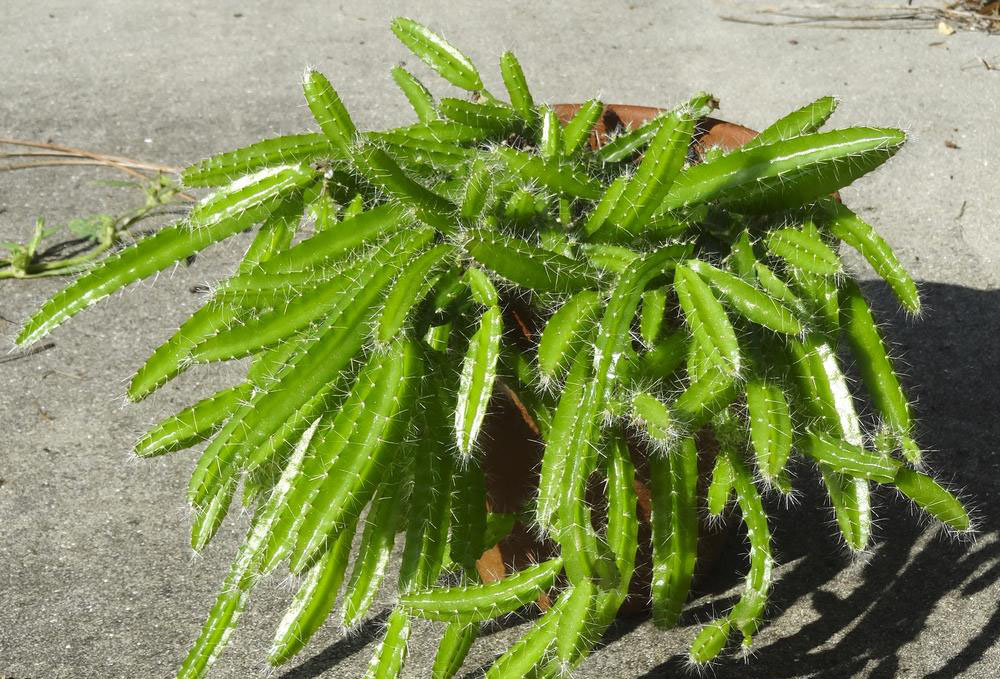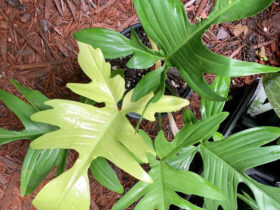An Enthralling Succulent
Embark on a fascinating journey as we dive deep into the world of the beguiling succulent known as the Dog Tail Cactus. Aptly named due to its resemblance to a canine’s wagging tail, this captivating cactus steals the spotlight in many household plant collections and botanical displays.
An Exotic Eye-Catcher

Hailing from Mexico, the Dog Tail Cactus, scientifically known as ‘Selenicereus testudo’, is renowned for its eye-catching appearance. It sports long, trailing stems that look much like a playful dog’s tail. Its striking appeal does not stop there. This intriguing cactus blooms at night, showcasing radiant white flowers that contrast brilliantly against its green, ribbed stems.
Fostering An Unusual Beauty
Despite its exotic appeal, the Dog Tail Cactus is a pretty low-maintenance plant. It is hardy, resilient, and can thrive under conditions where other plants might falter. These qualities, combined with its gorgeous aesthetic, explain the growing popularity of the Dog Tail Cactus among both novices and experienced plant enthusiasts.
A Popular Choice for Green Thumbs
When you add a Dog Tail Cactus to your plant collection, you aren’t just acquiring a green plant. You are inviting an exotic charm that brings an element of the extraordinary to your living space. Due to its low-maintenance nature, it presents an opportunity for rookie gardeners to dip their toes into the world of cacti without feeling overwhelmed.
As we progress through this article, you will have an opportunity to learn more about this intriguing cactus. We will delve into its distinct characteristics, ideal care settings, propagation techniques, and much more.
A Succulent with a Canine Touch
As we explore more about the Dog Tail Cactus, our understanding of its unique characteristics starts to become clearer. Named for its long, tail-like stems that mirror the appearance of a dog’s tail, this unusual plant species stands out among cacti enthusiasts. But what else defines this captivating succulent? Let’s dive in and unravel the mystery.
Meeting the Scientific Family
Belonging to the genus Selenicereus, the Dog Tail Cactus bears the scientific name ‘Selenicereus testudo.’ It is part of the larger Cactaceae family, home to thousands of cacti species. This cactus variety originates from the dry, rocky regions of Mexico, showcasing an exceptional ability to thrive in arid environments.
More Than Just A Pretty Face
While the Dog Tail Cactus is most famous for its fleshy, ribbed stems, it also offers generous flowers that are nothing short of breathtaking. These nocturnal blooms unfurl during the night, revealing large, fragrant white flowers that add a refreshing touch to the plant’s already fascinating appearance.
Adapting and Conquering Dog Tail Cactus
This plant’s toughness can be attributed to its native environment. It has evolved in the Mexican desert to store water efficiently and use few resources, making it an adaptable and resilient succulent. As a result, it distinguishes itself among houseplants as a low-maintenance, long-lasting option that can withstand a variety of conditions.
Understanding the Characteristics of Dog Tail Cactus
Delving deeper into the world of Dog Tail Cactus, we now turn our attention towards understanding this fascinating plant’s defining characteristics. From its distinctive shape and size to its growth habit, there are many unique traits that contribute to the charm of this succulent.
The Recognisable Appearance
Arguably, the most distinctive aspect of the Dog Tail Cactus is its iconic shape. The cactus features long, ribbed stems that curve and twist, mimicking the appearance of a friendly canine’s tail. These stems are green in color and covered with short spines, adding an extra layer of intriguing texture to the plant.
Dog Tail Cactus Size Does Matter
This plant can grow quite large in terms of size. While its width remains small, its stems can grow to be several feet long. Because of its trailing growth habit, plants are ideal for hanging baskets or tall pots where their dramatic length can be properly showcased.
Nighttime Bloomer
One of the most captivating traits of the Dog Tail Cactus is its behavior as a nocturnal bloomer. When in bloom, the cactus produces large, white flowers that unfurl during the night, filling the surrounding space with a sweet, enchanting fragrance. These blooms not only enhance the plant’s aesthetic but also create an entrancing night-time spectacle.
Growth Habit: Slow but Steady
Dog Tail Cacti are not the fastest growers. They have a relatively slow growth rate, but they make up for it with their longevity and resilience. With the right care and conditions, this cactus can become a long-term, hardy addition to any plant collection.
Propagating the Dog Tail Cactus: Growing New Plant Babies

It is not necessary to visit a nursery to add more Dog Tail Cactus plants to your collection. In fact, you can propagate your own palnts at home with a few simple steps. Here, we delve into the fascinating propagation process of this succulent, arming you with all the knowledge you need to breed more of these beauties.
Propagation: A Simple Stem Cutting Method
This plant is typically propagated through stem cutting. Before we begin, keep in mind that cactus spines can be sharp, so it’s best to wear gloves to protect your hands.
Step 1: Choosing the Right Stem
Look for a healthy, mature stem on your Dog Tail Cactus, preferably one that is about six inches long. Using a clean and sharp garden knife or a pair of pruning shears, carefully cut off the chosen stem.
Step 2: Prepping the Cutting
Once you’ve taken the cutting, it’s crucial to set it aside for a few days. This waiting period allows the cut end to form a callous or a hardened surface, which helps to protect your new plant from infection when it’s planted.
Step 3: Cutting Dog Tail Cactus Planting
After the cut end has thoroughly dried and calloused over, it’s time to plant your cutting. Prepare a pot with a well-draining cactus or succulent mix. Push the calloused end of your stem gently into the soil, packing the mix lightly around it to provide support.
Step 4: Take Care of Your Dog Tail Cactus
Water your new plant lightly and keep it in a warm area with plenty of indirect sunlight. After a couple of weeks, your cutting should begin to develop roots and establish itself as a new Dog Tail Cactus.
Plant propagation can be a rewarding experience that allows you to add more of these wonderful plants to your collection or share them with other plant enthusiasts. Remember that patience is essential. It may take some time for your new plant to establish itself, but the wait will be worthwhile once you see it begin to grow and flourish.
The understanding of these characteristics equips you with powerful insights to take proper care of your plants.
Common Problems with Dog Tail Cactus: Identifying and Providing Solutions
While this plant is relatively low-maintenance, it can face challenges just like any other houseplant. Whether it’s dealing with a pest infestation or showing signs of poor health due to unfavorable conditions, being aware of these issues allows for quick action. Here, we’ll look at some of the most common issues you might have with your plants, as well as solutions to them.
Issue 1: Overwatering Woes
While Dog Tail Cacti have a keen ability to store water for dry spells, they aren’t a fan of constantly soggy soil. Overwatering can lead to root rot – a deadly disease for any cactus.
The Solution:
Water your plants only when the top inch of the soil has dried out completely. Always remember, it’s better to underwater than overdo it when it comes to cacti.
Issue 2: Sunburn Scars in Dog Tail Cactus
Surprisingly, despite being a sun-loving cactus, the Dog Tail Cactus can get sunburns. If exposed to intensely bright, direct sunlight for extended periods, it may develop brown, scaly spots – a telltale sign of sunburn.
The Solution:
Shift your plant to a spot where it can receive plenty of bright but indirect light. Reduce the exposure if you spot signs of sunburn to allow the plant to recover.
Issue 3: Pest Problems of Dog Tail Cactus
Like any houseplant, Dog Tail Cacti sometimes befriend undesirable guests – pests. The most common enemy is the mealybug, a pest that can damage the plant’s health.
The Solution:
If you spot any white, cottony masses on your cactus, that’s a mealybug alert. Immediately wash the plant with a gentle stream of water or wipe it with a cotton ball soaked in alcohol to remove the pests. Frequently check for any signs of re-infestation and treat accordingly.
Issue 4: Slow Growth Dog Tail Cactus
While a slow growth rate is entirely typical for Dog Tail Cacti, no growth at all could indicate a problem. If your cactus isn’t growing despite providing the right care conditions, it might be due to insufficient nutrients.
The Solution:
Consider using a well-balanced, water-soluble cactus fertilizer during the growing season to provide a boost. Apply as per the instructions, taking care not to over-fertilize, which can cause more harm than good.
Why Own a Dog Tail Cactus: Unearthing the Benefits
You may be wondering why you should add this plant to your plant collection. Its distinct appearance and night-time blooming routine are undeniably appealing, but are there any other advantages? A broader picture emerges as we look at some of the main reasons why owning a Dog Tail Cactus can be rewarding.
Benefit 1: A Visual Treat for the Home
The Dog Tail Cactus, with its elongated, ribbed stems and stunning, fragrant flowers, is a visual delight. Its intriguing shape can add a unique structural element to your indoor garden, making the cactus a valuable addition to your home decor.
Benefit 2: Low-Maintenance and Resilient
The Dog Tail Cactus’s desert origins have equipped it with the ability to endure less-than-perfect care. Even if you are a beginner to plant care or have a busy lifestyle, this cactus, being drought-tolerant and resilient, demands low maintenance.
Benefit 3: Air-Purifying Qualities
As with most houseplants, the Dog Tail Cactus also contributes to purifying the air. While it might not be the top-scoring plant in the air-purifying game, it still helps remove toxins and increase oxygen levels inside your home.
Benefit 4: Contributes to Well-Being
Plants can contribute significantly to improving our mental well-being and reducing stress. Having a Dog Tail Cactus around, with its fascinating shape and exciting growth habits, can awaken curiosity, spark joy and serve as a constant reminder of nature’s incredible variety.
Benefit 5: An Unusual Night-time Spectacle
The nighttime blooming nature of the Dog Tail Cactus is undeniably a superstar feature. Being able to observe this unusual spectacle of bursting blooms in the quiet of the night provides a unique, almost magical experience that few other houseplants offer.
The Dog Tail Cactus, with its unforgettable appearance, low care requirements, and delightful quirks, appeals to both experts and amateur gardening enthusiasts. This striking cactus brings so much to the table, from its intriguing shape, which adds an architectural element to your space, to its stunning night-time bloom spectacle.
Furthermore, its resistance to a variety of care conditions, air purification abilities, and contribution to mental well-being make this plant an excellent addition to any indoor garden.
So why wait? Allow this amazing cactus to infuse your space and life with its unique qualities and captivating charm.















Leave a Reply